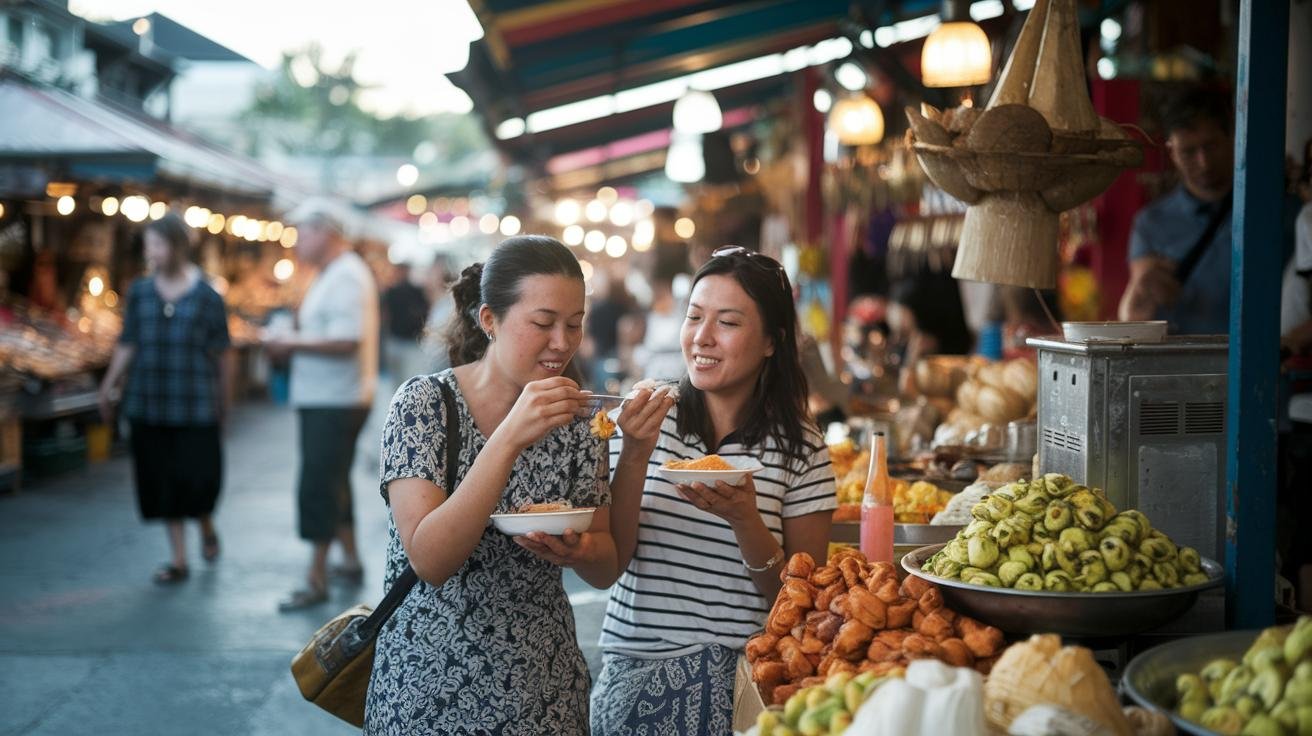2. Balinese cultural foods to try in Ubud Bliss
I bet the real soul of Ubud isn’t a temple but a plate of Ayam Betutu (Balinese spiced chicken slow-roasted in banana leaves). Ever tried it?
Imagine drifting past rice terraces (stepped fields that glow emerald at sunrise). You can almost taste the smoky drift of coconut husks. Tiny warungs (local eateries) peek out from under palm fronds, as if calling your name.
Steam curls from a banana leaf bundle, bringing lemongrass and bright turmeric right to your nose. Pure bliss.
Ready for a flavor tour? Savor Ayam Betutu, crackling duck (bebek betutu), and tender slow-roasted pig (babi guling). Each bite is a warm welcome to Balinese tradition.
2. Balinese cultural foods to try in Ubud Bliss

Ubud’s rice terraces (stepped fields that glow emerald at sunrise) and the soft murmur of the jungle set the scene for a tasty adventure. You’ll wander down hidden lanes, following the spicy scent of grilled meat and coconut. And around every corner you’ll spot warungs (local eateries) where time-honored recipes wait.
Imagine lifting the lid off a steaming pot of Ayam Betutu (spiced chicken roasted in banana leaves). Steam curls up slow, carrying lemongrass and turmeric right to your nose. Then there’s Bebek Betutu (duck slow-cooked till its skin crackles golden) and Babi Guling (suckling pig roasted over a wood fire) that melts on your tongue. Pure bliss.
Next, line them all up for a full edible tour:
- Ayam Betutu (spiced chicken roasted in banana leaves)
- Bebek Betutu (duck slow-cooked with lemongrass)
- Babi Guling (suckling pig roasted over a wood fire)
- Nasi Campur (mixed rice served with small side dishes)
- Lawar (chopped greens tossed with coconut and spices)
- Sate Lilit (minced fish satay wrapped around lemongrass stalks)
- Tipat Cantok (rice cake salad dressed in peanut sauce)
- Dadar Gulung (pandan pancakes filled with sweet coconut)
- Jaja Bali (assorted Balinese sweets)
- Klepon (glutinous rice balls oozing palm sugar)
Your taste buds are in for a ride, one bite at a time.
Babi Guling: Top Ubud Spots for This Balinese Cultural Food

Ubud’s famous Babi Guling (Balinese roast pig) comes alive in cozy warungs (small local cafés). Picture the aroma of sizzling pork mingling with the murmur of morning chatter. Locals gather before sunrise, plates piled high with crackling skin.
Warm bowls of pork-bone soup steam between shared smiles. Ever wondered what pure Balinese comfort tastes like?
| Warung | Specialty | Hours & Tips |
|---|---|---|
| Ibu Oka | Ultra-crispy skin and pork-bone soup | Opens at 11:00 AM. Often sells out by noon. |
| Ibu Gendut | Mixed pork cuts, pork satay, bone broth | Spacious seating and a local favorite. |
| Gung Cung | Juicy meat with balanced spices | 11:00 AM–4:30 PM or until gone. Rooftop dining. |
Timing is everything here. Aim to arrive just as Ibu Oka opens to snag that extra-crisp skin. Most warungs run on cash only, so tuck a few small bills in your pocket.
The servings can be generous. Sharing a half plate at Gung Cung lets you sample the pork-bone soup too.
Next, pace yourself. Alternate a crunchy bite with a warm spoonful of broth or a fluff of steamed rice.
At Ibu Gendut, simply let them know your spice comfort zone and they’ll adjust the heat just for you.
Then lean back and listen to the friendly buzz around the table. Pure bliss.
Ayam Betutu & Bebek Betutu: Signature Balinese Cultural Foods in Ubud

Ayam Betutu feels like a hug from Bali. It starts with Bumbu Bali (spice mix of chili, turmeric, galangal, and lemongrass) gently rubbed into every nook of the chicken. Then you wrap it in banana leaves (large tropical leaves) and nestle it in a low, slow fire for about 12 hours. Sometimes it’s even buried under coconut husks (the rough shell of coconuts) for extra smokiness.
By the end, the meat slides right off the bone, leaving a warm, tender bite. You’ll notice earthy turmeric (bright yellow root) and the fresh zing of lemongrass (citrusy grass). Pure bliss. Oops, did I mention it’s a star at village ceremonies?
In Ubud, Casa Luna is a local favorite for its farm-to-table touch. Pair your Ayam Betutu with sambal matah (Balinese raw chili relish) for a tangy kick that cuts through the mellow spices.
Meet Bebek Betutu. It uses the same Bumbu Bali but adds an extra step to tame the duck’s natural richness. First, chefs massage the bird and steam it to lock in the juices. Then they roast it over coconut husks for a crackling finish and a smoky aroma.
The result is a richer, fattier meat bursting with savory depth and a hint of sweetness. At Casa Luna, they serve it as a celebratory feast alongside fresh local greens and more sambal matah. Ever dreamed of mastering these flavors? Join one of their cooking classes and learn how to bring this festive dish to your own table.
Lawar, Sate Lilit & Nasi Campur: Core Balinese Cultural Foods to Try in Ubud

Imagine stepping into Pasar Ubud at dawn: the sky blushes pink, the air is sweet with ylang-ylang, and you hear the soft murmur of early shoppers. There you’ll find Lawar Ubud (a sacred salad once served at temples). It’s a mix of ketupat rice cakes (compact rice patties), steamed greens, and freshly grated coconut. Then it’s tossed in a creamy sauce made from Balinese spice paste and coconut milk. Rare. Like a hidden ritual.
You can almost picture villagers gathering around long bamboo tables. Each bite of Lawar lingers with whispers of ancestral recipes. It’s community in a bowl. Ever shared a meal that felt like a hug? This is it.
Next, let’s talk Sate Lilit. Head to cozy warungs (local eateries) like Warung Pulau and Semara. Here, minced fish, chicken, or pork meets extra coconut and fragrant spices, all molded onto lemongrass stalks (for a citrusy hint). Then it’s grilled over smoldering coconut husks. The smoke drifts into the air, carrying warm scents of coconut oil and charred lemongrass. Pure bliss.
Nasi Campur Ubud turns simple rice into an art form. A mound of steamed rice lands on a banana leaf with shredded chicken, crunchy fried peanuts, and colorful urab vegetables (spiced veggie mix). You’ll also get a skewer of Sate Lilit and a spoonful of house-made sambal (spicy chili paste). Sweet, spicy, nutty, every bite is a little party.
By the way, locals swear by Nasi Campur Ayam with tender chicken strands woven through. Share it at a wooden table in Sun di Bisma Warung, Murni’s Warung, or tucked into your villa’s private nook. Don’t skip the extra sambal or a side of Lawar for the full island feast.
Sweet Balinese Cultural Desserts & Snacks to Try in Ubud

Ubud’s dessert scene feels like a cool breeze after its famous spicy dishes. After a plate of nasi campur (mixed rice with veggies, meats, and spicy sambal) or crispy babi guling (roast suckling pig), you’ll crave something mild and sweet. Imagine the gentle rustle of coconut palms as you dig in. Tranquility.
First there’s dadar gulung (pandan-scented rice-flour crepe rolled around grated coconut and palm sugar filling) – a soft, chewy hug for your taste buds. Klepon (glutinous rice balls hiding molten palm sugar) burst with a sweet rush as soon as you bite. Bubur injin (sweet black-rice porridge topped with coconut cream) warms you from the inside out. And don’t miss laklak pancake (pandan-tinted green rice-flour pancake drizzled with palm sugar and coconut) or jaja bali (bite-size pastel cakes) for a playful taste parade.
At Pasar Ubud (local morning market) pre-dawn lantern light makes jaja bali glow on banana leaves. Oops, I mean it’s like a pastel sunrise under your fingertips. Then find the laklak pancake cart just off Jalan Raya Ubud. Handheld griddles bubble out fragrant green cakes in minutes!
For klepon, follow the sweet steam to Ibu Wayan’s roadside stand near Pura Taman Saraswati (water temple). Each ball oozes molten sugar like a little treasure. Ever dreamed of a dessert that surprises you?
Bubur injin sparkles at Sun De Bisma Warung, where warm black rice meets creamy coconut swirls in a clay bowl. It’s pure, cozy comfort – a hug in a spoon.
As dusk settles, roadside pushcarts by Ubud Palace tempt you with fresh dadar gulung. Crepes fold soft coconut ribbons into every bite. Next, for a modern courtyard vibe, head to Melali Ubud. Their refined takes on these classics come with an extra drizzle of palm sugar.
Balinese Cultural Beverages & Coffee Experiences in Ubud

Steam curls from a warm cup of Kopi Luwak (civet coffee) in a cozy Ubud café. You’ll breathe in its rich, earthy aroma, the beans once passed through a civet’s digestive tract, then roasted just right. And if you pop into any Ubud coffee shop, you’ll see Bali iced coffee, strong brew sweetened with palm sugar and condensed milk over ice, waving at you like an old friend.
Ever dreamed of a coffee tasting that feels like a mini adventure? At Seniman Coffee and Montana Del Cafe, friendly baristas guide you through tasting flights. You’ll start with light, floral beans grown on volcanic slopes, then drift to dark roasts with smoky whispers.
Next, sign up for a coffee plantation tour at a nearby estate. You’ll wander under a jungle canopy, past rows of glossy coffee cherries, and learn about Luwak processing. Pick a berry, husk it yourself, then watch (and smell) the roasting right at the mill. It’s hands-on fun, perfect before you head off to explore a temple in the afternoon.
Jamu Bali (traditional herbal tonic) calls you at market stalls around Ubud Palace. This turmeric-ginger-tamarind elixir warms you from the inside out, its golden glow catching the morning light. Street vendors ladle out blends of bitter roots and sweet palm sugar, each cup a little burst of island wellness.
By dusk, find a hidden lounge and sip Arak Bali (rice-wine spirit) in a modern cocktail. The crisp tang of coconut-fermented rice meets local citrus and a hint of chili. Pure bliss. You’ll taste Bali’s ceremonial heart in every glass.
Ubud Food Markets & Warungs for Authentic Balinese Cultural Foods

Ever dreamed of discovering breakfast tucked away behind Pasar Ubud’s stalls?
- Nasi Jinggo (tiny rice parcels wrapped in banana leaf (fragrant folded leaf)) sits on little trays at dawn. For just a few cents you get a warm, spicy rice nibble that feels like a local hug.
- Siboghana’s vegan slow-food corner turns fresh greens into creamy coconut curry and nut-brown tempeh bites. Pure comfort.
- Naughty Nuri’s, not far from the Neka Museum, serves sticky pork ribs slathered in tangy BBQ sauce. No fork needed.
Warung-Going Tips
- Arrive early. The best warung dishes vanish by midmorning.
- Whisper “pedas” (spicy) and point if you need a chili boost.
- Pinch rice or lift skewers right off the banana-leaf plate with your fingers. It’s part of the fun.
- Pass plates around so everyone can taste every flavor. Because sharing is caring.
Cooking Classes & Ubud Food Tours for Balinese Cultural Foods

Ever dreamed of rolling your own spice paste with henna-stained hands? Our hands-on cooking class at Plataran Resort in Ubud shows you how to make lawar (spiced coconut salad), sate lilit (seafood kebabs), pepes ikan (steamed fish parcels), and dadar gulung (pandan crepes). First, you’ll crush fresh chilies and herbs, then grill bamboo skewers over glowing coals. After that, we settle under frangipani trees (flowers with a sweet, honeyed scent) to savor everything you helped create.
Or maybe you’d rather wander through Ubud’s flavors. Join our food tour at dawn and follow a local guide between warung stalls (street-hut eateries), hidden cafés, and Pasar Ubud’s morning market. You’ll taste each bite while listening to stories about the spices that make Balinese cooking so unforgettable.
Each cooking class runs about four hours and stays small, just eight guests max, so it feels more like cooking with friends. We pick you up and drop you off, supply every ingredient, serve a welcome herbal drink, and send you home with a printed recipe booklet. Lunch is al fresco, right in our garden where the air smells like frangipani and green leaves.
Our Ubud food tour lasts two to three hours, starting around sunrise when the sky’s still pink. We sample six local treats, from nasi jinggo (little parcels of rice and sides) to more sate lilit, while weaving in history and spice lore. I guess you could say it’s a taste-and-tell adventure.
Want to bring this feast to your villa? Check out how to hire a private chef for a villa in Bali: https://villaamrita.com/?p=6723
Book your cooking class or Ubud food tour up to a week ahead to save your spot. Tranquility, and flavor, await.
Final Words
Diving into Ubud’s flavors, we sampled ten must-try dishes and scoped out top warungs for crispy Babi Guling. Next, we explored Ayam Betutu and Bebek Betutu’s slow-cooked richness alongside Lawar, Sate Lilit and Nasi Campur staples.
Sweet treats like Klepon and Dadar Gulung met us, then local brews, Kopi Luwak and fresh jamu. You also got market tips, hidden warung finds and hands-on cooking classes.
It’s time to plan your feast and embrace Balinese cultural foods to try in Ubud.
FAQ
What are the must-try Balinese dishes in Ubud for dinner?
The must-try Balinese dishes in Ubud for dinner include Babi Guling (spit-roasted pork), Ayam Betutu (spiced slow-cooked chicken), and Lawar (mixed vegetables with coconut).
What do locals eat in Bali?
Locals in Bali eat simple rice-based meals such as Nasi Campur (mixed rice plate), Nasi Goreng (fried rice), and Gado-Gado (vegetable salad with peanut sauce).
What traditional Balinese foods should vegetarians try?
Vegetarian visitors to Bali should try Tipat Cantok (rice-cake salad with peanut sauce), Gado-Gado (mixed veggies with peanut dressing), and Urab (steamed vegetables tossed in coconut and spices).
What foods are safe to eat in Bali?
Safe foods to eat in Bali are hot, freshly cooked dishes like Nasi Goreng and Sate Lilit, bottled water, and sealed snacks. Avoid raw salads unless from trusted spots to prevent an upset stomach.
What is Bali’s national dish?
Bali’s national dish is Babi Guling, a spit-roasted suckling pig seasoned with turmeric, garlic, and traditional spices, often served shredded with rice and spicy sambal.
What are some popular Balinese dishes?
Popular Balinese dishes include Nasi Goreng (fried rice), Mie Goreng (fried noodles), Satay (grilled skewers), Rendang (slow-cooked beef stew), and Betutu (spiced meat wrapped in banana leaf).







